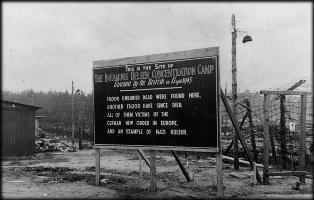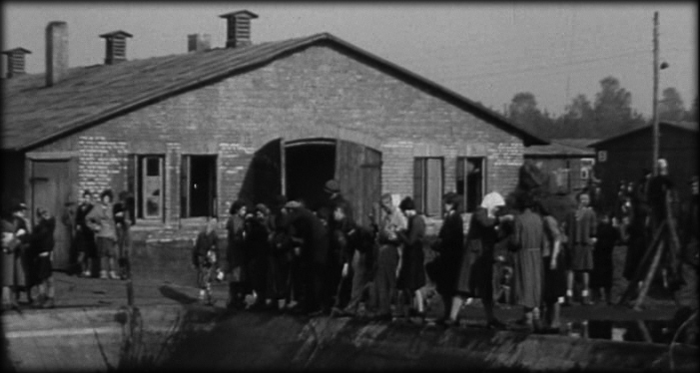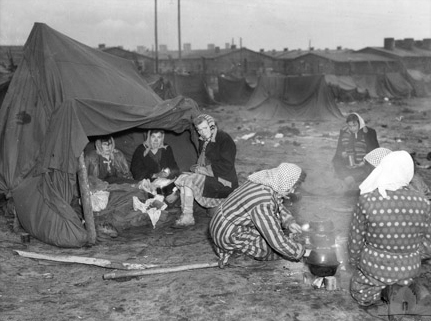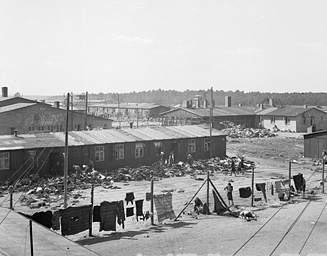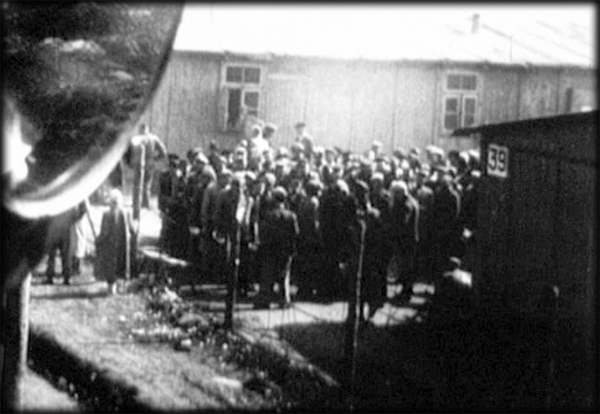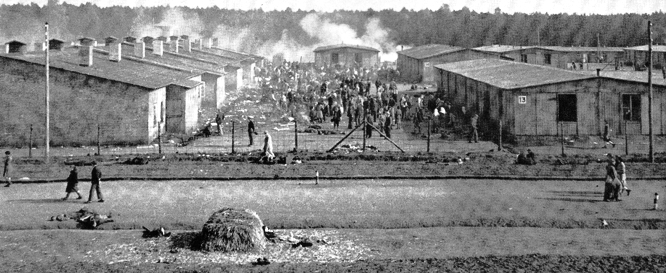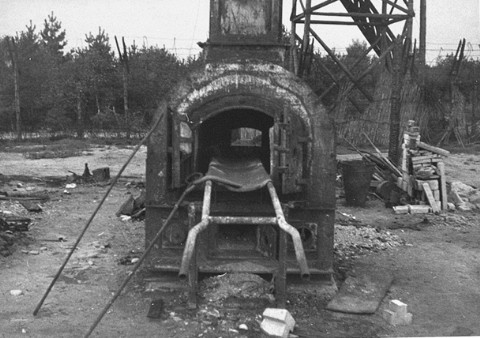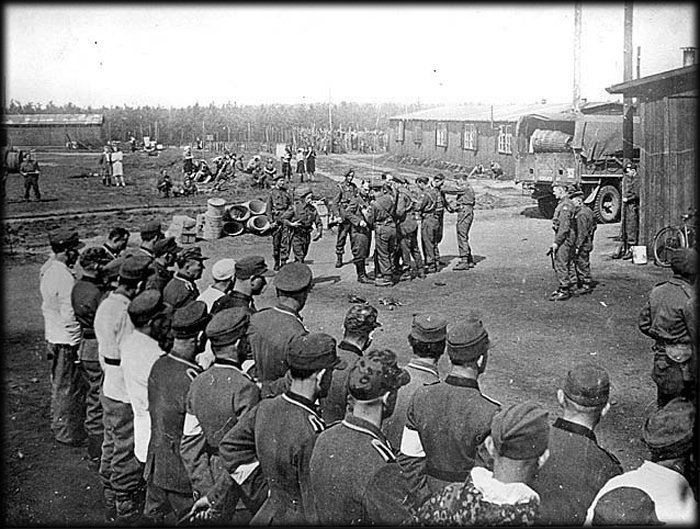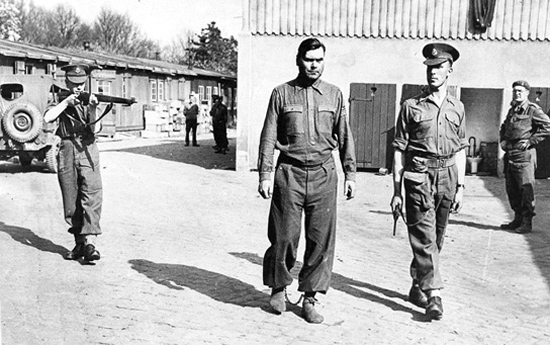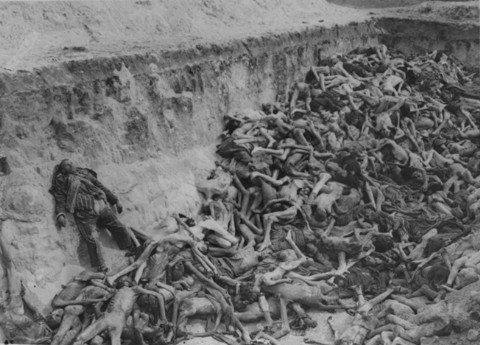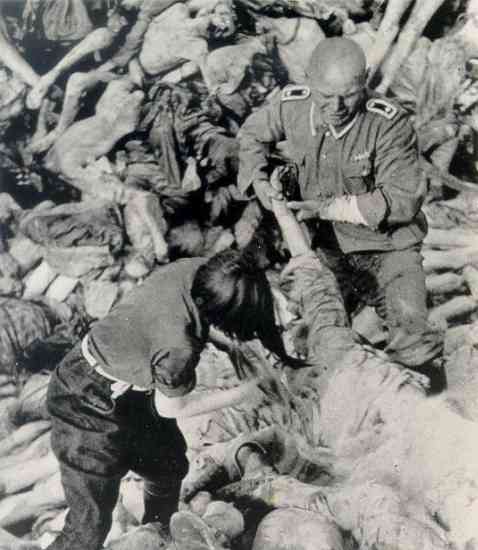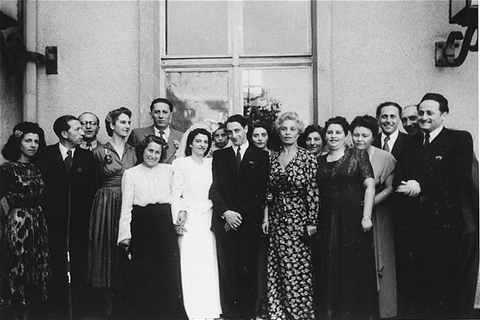Holocaust Education & Archive Research Team |
|
Other Camps
Key Nazi personalities in the Camp System The Labor & Extermination Camps
Auschwitz/Birkenau Jasenovac Klooga Majdanek Plaszow The Labor Camps
Trawniki
Concentration Camps
Transit Camps
|
|||||||
Bergen - Belsen
Bergen – Belsen was a concentration camp located in Lower Saxony, northern Germany, near the city of Celle. The camp was officially established in April 1943 as an Aufenthaltslager (detention camp) for holding persons who were designated for exchange with German nationals in Allied countries whom the Germans wanted to repatriate.
A prisoner-of- war camp on the site, Stalag 311, was partially cleared to make room for the new camp. From its inception Bergen- Belsen came under the SS-WVHA, which was in charge of the administration of concentration camps.
The first commandant of Bergen –Belsen was SS- Obersturmbannfuhrer Adolf Haas, who was killed in action on 31 March 1945, he was succeeded by SS-Hauptsturmfuhrer Josef Kramer who had served in a number of concentration camps including Dachau, Mauthausen, and was Commandant in Birkenau and Natzweiler.
Five hundred Jewish prisoners from the Buchenwald and Natzweiler camps were taken to Bergen- Belsen to work on the construction of the camp, they were not candidates for exchange and belonged to the Baukommando (construction department).
In the course of the first eighteen months of the camps existence five satellite camps were set up, unconnected with one another as follows:
Prisoners Camp - Haftlingslager
This was the first satellite camp built for the first 500 prisoners who had been brought in for the construction of the camp. The conditions in this camp were among the worst possible, and the mortality rate was very high.
This camp was closed on 23 February 1944, and the few surviving prisoners were transferred to Sachsenhausen concentration camp.
Special Camp – Sonderlager
In mid-June 1943, two transports of Jews from Poland, mainly from Lvov, Krakow and Warsaw totalling 2,400 persons, were taken to this camp, these were Jews who had papers in their possession issued by various countries, mostly South American.
On 23 October 1943, 1,800 of these Jews arrived in Auschwitz where they were all immediately killed. During the undressing, prior to entering the gas chambers one woman throws her clothes at SS- Scharfuhrer Schillinger grabs his revolver and shoots him three times. She also shoots SS- Unterscharfuhrer Emmerich. Reinforcements were called, some women were shot, the rest are driven into the gas chamber and killed. Schillinger died on the way to the hospital, Emmerich recovered but was crippled.
Another 350 suffered the same fate in early 1944, this left 350 detainees in the camp, of whom 266 were in possession of immigration permits to Palestine, 34 were United States citizens and 50 had South American papers. These prisoners were not assigned to work teams and no contact was permitted between them and other groups of Bergen- Belsen prisoners.
Neutral Camp – Neutralenlager
This camp contained two barracks in which 350 Jewish prisoners were housed from late July 1944 to early March 1945. The prisoners were nationals of neutral countries, among them 155 Spanish, 105 Turkish, 35 Argentine, and 19 Portuguese citizens.
Conditions in this camp were better than in any other part of Bergen-Belsen. The prisoners here were not put to work, enjoyed better nourishment and sanitary conditions, and were treated by the SS with less cruelty than were the prisoners in the other satellite camps.
Star Camp – Sternenlager
This was the largest of the five satellite camps, containing eighteen barracks. It housed Jewish prisoners who ostensibly were designated for exchange. These prisoners did not wear the usual concentration camp uniform and were permitted to wear their own clothes, but they had to wear a yellow Star of David, from which came the name Star Camp.
Men and women lived in separate barracks, but members of the same family were permitted to meet. Most of the prisoners in the “star camp” were Jews from the Netherlands. In the period from January to September 1944, eight transports from the Westerbork transit camp in the Netherlands arrived in Bergen- Belsen, made up of 3,670 persons who were classified as “exchange Jews.”
In the first half of 1944, the “star camp” also took in small transports of Jews from various other countries. These included 200 Jews from Tunisia, Tripoli, and Benghazi , who until then had been held in the Fossoli di Carpi camp in Italy: 200 Jewish women from the Drancy transit camp in France, whose husbands were French prisoners-of –war, being held by the Germans, and several hundred Jews from Yugoslavia and Albania.
According to a count taken on 31 July 1944 the “star camp” contained a total of 4,100 Jewish prisoners classified as “exchange Jews.”
Hungarian Camp – Ungarnlager
This camp was established on 8 July 1944 and held 1,684 Jews from Hungary – the transport organised by Dr Rezso (Rudolf) Kasztner. Here too, the prisoners wore their own clothes but were forced to display the yellow star.
Only a few of the Jews who were brought to Bergen-Belsen as candidates for exchange were in fact set free in exchange deals. On 10 July 1944, 222 Jews with immigration certificates to Palestine landed at the Haifa port.
A few weeks later, on 21 August, 318 Jews from the “Hungarian Camp” reached Switzerland, followed by another 1,365 in December. In January 1945, 136 Jews with South American papers also reached Switzerland.
Beginning in March 1944, Bergen- Belsen gradually became a “regular” concentration camp, the Germans transferring to it prisoners from other concentrations camps who were classified as ill and unfit to work.
The first such group came in late March 1944 and consisted of 1,000 sick prisoners from the Dora camp. They were put into a new section of the camp where the sanitary conditions were extremely poor, they received no blankets, no medical attention and only minute food rations. Nearly all of them died within a short period -on the day of the camps liberation only 57 of the original 1,000 were still alive. More transports of prisoners “unfit for work” kept arriving from various camps up to the end of 1944, most of them made up of Hungarian Jews.
The majority were housed in the former “prisoners camp,” where conditions were at their worst and the mortality rate was the highest. Of the several thousand prisoners brought to this section of the camp in 1944, 820 died in the period from April to June alone.
Also transferred to this section of the camp were German convicts from the Dora camp, who were appointed “block elders” and Kapos, who treated the Jewish prisoners under their authority with great brutality, and caused a great number of cruel deaths.
The prisoners also suffered from the sadistic practices of the camp doctor, Obersturmfuhrer Dr Karl Jager, who forced them to keep running for long stretches of time. In the summer of 1944 some 200 prisoners were killed by phenol injections.
In August 1944 a new section was added, to serve as a women’s camp, consisting of twelve barracks, 4,000 Jewish women prisoners from Hungary and Poland were brought there, but after a short stay they were sent to Buchenwald and Flossenburg camps, to perform forced labour. Most of the women returned to Bergen-Belsen sick or exhausted by the hard labour that they had been forced to do.
In September and October 1944 transports of Jewish prisoners from the Plaszow camp, near Krakow, and 3,000 Jewish women prisoners from Auschwitz arrived in Bergen-Belsen, they were housed in the “star camp,” in new barracks put up for them, with no water, no beds, and no other facilities of any kind.
Among these prisoners were Anne Frank and her sister Margot, who both died in March 1945 from the typhus epidemic that raged through the camp.
On 2 December 1944 Adolf Haas the camp commandant was replaced by Hauptsturmfuhrer Josef Kramer. A census taken on 2 December 1944 showed that the camp population was 15,257 persons, of whom some 8,000 were women.
Kramer’s first step was to convert Bergen- Belsen officially into a concentration camp, the residues of self-administration that still existed in the “star camp” were abolished, and the internal management of the camp was put into the hands of the “block elders” and Kapos, as was done in all other concentration camps.
A final and complete deterioration of the prisoners living conditions set in when tens of thousands of prisoners poured in – survivors of the death marches who had been evacuated from the camps in the east. These included 20,000 women prisoners from the Auschwitz- Birkenau concentration camps who had passed through the Gross- Rosen concentration camp on the death march to Bergen-Belsen.
In the period from January to March 1945 there were more death marches which brought thousands of male prisoners from the Sachsenhausen and Buchenwald concentration camps to Bergen-Belsen.
The camp administration did nothing to house the prisoners who were streaming in. Most of them had no roof over their heads, and were without water and food. There was now total chaos in Bergen- Belsen and a typhus epidemic broke out, in the month of March alone 18,168 prisoners perished in the camp and the number of deaths for the period from January to mid-April 1945 was 35,000.
On 15 April 1945, Bergen- Belsen was liberated by the British army. There were 60,000 prisoners in the camp, most of them in a critical condition. Thousands of unburied bodies were strewn all over the camp grounds.
One member of the British liberation forces, William Rutherford a sapper in the Royal Engineers never forgot the horrors of Bergen - Belsen, he was one of the drivers of the bulldozers that filled the mass graves:
“Even though it was years ago that sweet sickly smell stayed in my nostrils, we never knew till after the war that the camp inmates were mostly Jewish, they were just displaced persons – those poor people.”
The sight put the British prisoners into a state of shock. The British had not anticipated the immediate rescue requirements and in the first five days following liberation, 14,000 persons died, another similar number succumbed in the following weeks.
After the liberation Bergen-Belsen became the site of a Displaced Persons (DP) camp, the British army medical corps helping in the physical rehabilitation of the former prisoners. Several inmates were even married in the camp during this period.
The displaced persons’ camp was in existence up to 1951, with the inmates under the leadership of Josef Rosensaft, managing to organise a lively social, cultural, and political life in the camp.
The trial of forty-eight members of the camp staff of Bergen- Belsen among them sixteen women, by a British military court was held in Luneburg, Germany, from 17 September to 17 November 1945. Eleven of the accused – including the camp commandant, Josef Kramer – were sentenced to death and on 12 December 1945, they were executed.
Sources: Encyclopedia of the Holocaust - Israel Gutman (Ed) - New York 1990. Auschwitz Chronicle 1939 – 1945 by Danuta Czech published by Henry Holt and Company New York 1989. Private correspondence with the author and William Rutherford. Imperial War Museum Archives.
Copyright: Chris Webb & Carmelo Lisciotto H.E.A.R.T 2007
|
